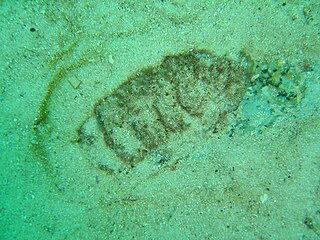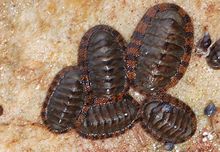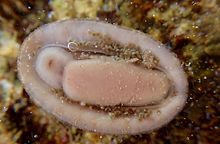
Chitons are marine molluscs of varying size in the class Polyplacophora, formerly known as Amphineura. About 940 extant and 430 fossil species are recognized.

Jasus lalandii, the Cape rock lobster or West Coast rock lobster, is a species of spiny lobster found off the coast of Southern Africa. It is not known whom the specific epithet lalandii commemorates, although it may the French naturalist and taxonomer Pierre Antoine Delalande.

The hairy chiton is a species of chiton in the family Chaetopleuridae. It is a marine mollusc.
Chaetopleura pertusa, the orange hairy chiton, is a species of chitons in the family Chaetopleuridae. It is a marine mollusc. It is endemic to South Africa.

Dinoplax gigas, the giant chiton, is a species of chiton in the family Chaetopleuridae. It is a marine mollusc.
The brooding anemone, Halianthella annularis, is a species of sea anemone in the family Halcampidae,.

The pink hermit crab is a species of hermit crab in the family Diogenidae.
Ischnochiton textilis, the textile chiton, is a medium-sized polyplacophoran mollusc in the family Ischnochitonidae, endemic to the coasts of South Africa and Namibia.
Ischnochiton oniscus, the dwarf chiton, is a small polyplacophoran mollusc in the family Ischnochitonidae, endemic to the coast of southern Africa.
Ischnochiton bergoti, the ribbed-scale chiton, is a small polyplacophoran mollusc in the family Ischnochitonidae, endemic to the west coast of southern Africa.
Chiton salihafui, the python chiton, is a medium-sized polyplacophoran mollusc in the family Chitonidae, found on the west coast of Africa.

Chiton politus, the tulip chiton, is a medium-sized polyplacophoran mollusc in the family Chitonidae, found on the coast of southern Africa.

Callochiton dentatus, the broad chiton, is a medium to large-sized polyplacophoran mollusc in the family Callochitonidae, found on the coast of southern Africa.

Acanthochitona garnoti, the spiny chiton, is a medium-sized polyplacophoran mollusc in the family Acanthochitonidae, found on the coast of southern Africa.

Onithochiton literatus, the black chiton, is a medium to large-sized polyplacophoran mollusc in the family Chitonidae, found on the east coast of Africa.

Dinoplax validifossus, the Natal giant chiton, is a large polyplacophoran mollusc in the family Chaetopleuridae, found on the eastern coast of southern Africa. It was originally considered a subspecies of the giant chiton.

The Marine biodiversity of South Africa is the variety of living organisms that live in the seas off the coast of South Africa. It includes genetic, species and ecosystems biodiversity in a range of habitats spread over a range of ecologically varied regions, influenced by the geomorphology of the seabed and circulation of major and local water masses, which distribute both living organisms and nutrients in complex and time-variable patterns.

Radsia is a genus of chitons belonging to the family Chitonidae.













